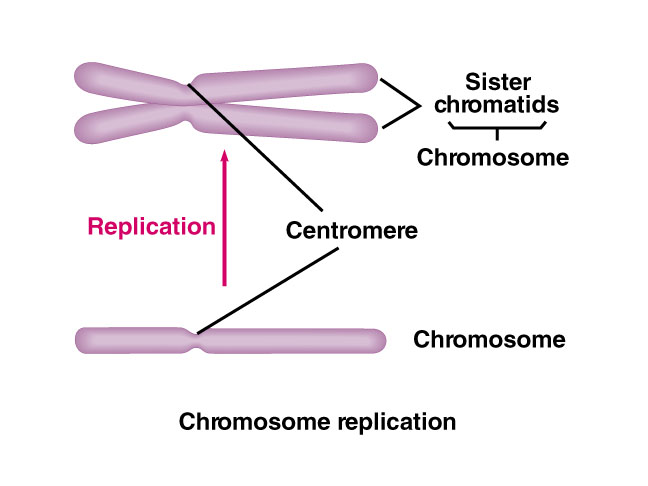Sister chromatids: Difference between revisions
No edit summary |
No edit summary |
||
| (4 intermediate revisions by one other user not shown) | |||
| Line 1: | Line 1: | ||
<span style="line-height: 1.5em; font-size: 13px;">Sister chromatids are two copies of the same [[chromosome|chromosome]] generated when the chromosome is replicated during synthesis phase (S) of interphase stage before mitotic division starts [Figure 1<ref>Collin County Community College District. (2013) The Formation of Sister Chromatids [Online] Available from: http://iws.collin.edu/biopage/faculty/mcculloch/1406/outlines/chapter%2011/Ar14-2a.JPG [Accessed 28th November 2013]</ref>]. In [[Meiosis|Meiosis]], the two sister [[chromatids|chromatids]] are joined together by cohesin compexes along their bodies <ref>Alberts B., Johnson A., Lewis J., Raff M., Roberts K., Walter P. (2008) Molecular Biology of The Cell, 5th Edition, New York: Garland Science.(Page 1272)</ref>. The two sister chromatids are segregated from each other into two different daughter cells during [[mitosis|mitosis]]. During [[prophase|prophase]] stage, sister chromatids are observed to be attached together at [[centromere|centromere]]. At [[metaphase|metaphase]] stage, chromosomes align singly on the equator and spindle fibres begin to attach to the [[kinetochores|kinetochores]] [[proteins|proteins]] found at centromere of the sister chromatids. The centromere of every chromosome then divides at anaphase stage, leading the separation of the two sister chromatids and each sister chromatid becomes individual chromosome, which is pulled by [[microtubules|microtubules]] to opposite poles. These separated sister chromatids start to uncoil and elongate to form chromatin fibres in two separate daughter cells during telophase and cytokinesis. Hence, sister chromatid cohesion is important for the correct distribution of genetic information between daughter cells and the repair of damaged chromosomes</span><ref>Jeff Hardin, et al. (2012) Becker’s World of Cell 8th Edition. San Fransisco. Pearson Education, Inc. Page 550 to 592.</ref>.<span style="line-height: 1.5em; font-size: 13px;"> Errors in the segregations and other mitotic processes may lead to aneuploidy and cancer, especially when checkpoints fail to detect DNA damage or dysfunctional [[mitotic spindles|mitotic spindles]] formation</span><ref>Cimini D, Mattiuzzo M, Torosantucci L, Degrassi F. (2003) Histone hyperacetylation in mitosis prevents sister chromatid separation and produces chromosome segregation defects. [Online] Available from: http://www.ncbi.nlm.nih.gov/pubmed/ [Accessed: 22nd November 2013]</ref>. | |||
[[Image:Sister Chromatids.JPG|Figure 1. The Formation of Sister Chromatids]] | |||
=== References === | |||
<references /> | <references /><br> | ||
Latest revision as of 02:23, 1 December 2013
Sister chromatids are two copies of the same chromosome generated when the chromosome is replicated during synthesis phase (S) of interphase stage before mitotic division starts [Figure 1[1]]. In Meiosis, the two sister chromatids are joined together by cohesin compexes along their bodies [2]. The two sister chromatids are segregated from each other into two different daughter cells during mitosis. During prophase stage, sister chromatids are observed to be attached together at centromere. At metaphase stage, chromosomes align singly on the equator and spindle fibres begin to attach to the kinetochores proteins found at centromere of the sister chromatids. The centromere of every chromosome then divides at anaphase stage, leading the separation of the two sister chromatids and each sister chromatid becomes individual chromosome, which is pulled by microtubules to opposite poles. These separated sister chromatids start to uncoil and elongate to form chromatin fibres in two separate daughter cells during telophase and cytokinesis. Hence, sister chromatid cohesion is important for the correct distribution of genetic information between daughter cells and the repair of damaged chromosomes[3]. Errors in the segregations and other mitotic processes may lead to aneuploidy and cancer, especially when checkpoints fail to detect DNA damage or dysfunctional mitotic spindles formation[4].
References
- ↑ Collin County Community College District. (2013) The Formation of Sister Chromatids [Online] Available from: http://iws.collin.edu/biopage/faculty/mcculloch/1406/outlines/chapter%2011/Ar14-2a.JPG [Accessed 28th November 2013]
- ↑ Alberts B., Johnson A., Lewis J., Raff M., Roberts K., Walter P. (2008) Molecular Biology of The Cell, 5th Edition, New York: Garland Science.(Page 1272)
- ↑ Jeff Hardin, et al. (2012) Becker’s World of Cell 8th Edition. San Fransisco. Pearson Education, Inc. Page 550 to 592.
- ↑ Cimini D, Mattiuzzo M, Torosantucci L, Degrassi F. (2003) Histone hyperacetylation in mitosis prevents sister chromatid separation and produces chromosome segregation defects. [Online] Available from: http://www.ncbi.nlm.nih.gov/pubmed/ [Accessed: 22nd November 2013]
